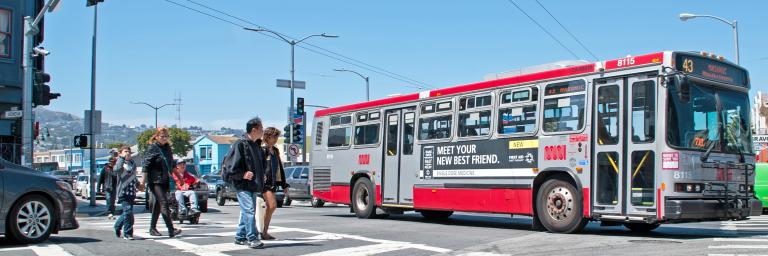At the April 16, 2024 SFMTA Board meeting, the SFMTA adopted the Muni Service Equity Strategy Report for Fiscal Years 2025 and 2026. Learn more through the slide deck and staff report.
Muni服務公平策略是該機構致力於讓所有乘客都能利用和負擔得起公共運輸的重要承諾的組成部分。
透過實施可快速實施的服務處理措施,同時實現重要的安全改善措施,連結主要目標、可靠性、頻率和擁擠程度,公平策略將使8個選定的公平鄰舍,長者和殘疾人士受益。此外,該策略將為服務每個公平鄰舍的Muni路線建立一個績效基準,並會每年進行監測。
The Muni Service Equity Strategy focuses on improving transit performance in San Francisco neighborhoods with high percentages of households with low incomes and people of color. The neighborhoods were selected based on the percentage of households with low incomes, private vehicle ownership and race and ethnicity demographics. As part of the analysis, SFMTA staff reviewed Clipper data to identify routes heavily used by seniors and people with disabilities.
The Equity Strategy was developed with the help of the Equity Working Group, which was formed by the SFMTA. The Equity Working Group includes the following government and community-based organizations: Chinatown Community Development Center, Council of Community Housing Organizations, San Francisco Bicycle Coalition, San Francisco County Transportation Authority, San Francisco Transit Riders Union, Senior Disability Action, Tenderloin Neighborhood Development Corporation, and Urban Habitat.
Going forward, the Equity Strategy will be presented to the SFMTA Board of Directors before the development of the two-year capital and operating budget and will inform the budget process to the extent that resources are available.
Note: The Oceanview-Ingleside neighborhood was recently added as an Equity Neighborhood based on stakeholder feedback and the neighborhood’s demographic diversity. Investment strategies will also be included in the FY 2019 and FY 2020 report.
PURPOSE
The Muni Service Equity Strategy aims to identify and address high priority transit needs in neighborhoods that rely on transit service the most with tangible solutions that can be implemented quickly (within one to two years) and deliver measurable improvements.
As a result, SFMTA staff developed preliminary key needs found in the 2016 Muni Service Equity report, based on system data such as crowding and on-time performance.
IDENTIFYING ROUTES USED BY SENIORS AND PEOPLE WITH DISABILITIES
SFMTA staff identified routes heavily used by seniors and people with disabilities by reviewing customer boarding data from Senior and Regional Transit Connection (RTC) Clipper Cards. Staff then noted the top 15 routes with both the highest number of Clipper Card boardings and the highest percentage of Clipper Card boardings as a percentage of total daily ridership. An analysis was also conducted using public comments marked as "ADA" complaints from San Francisco's non-emergency service provider, 311, in order to narrow down the transit lines that had high ridership.
NEXT STEPS
The project team is currently connecting with stakeholders in each Equity Neighborhood to better understand their transit challenges. Examples include, are there specific times in the day where it is hard to get around and what locations are hard to reach by public transit? The project team will then analyze whether there is overlap from the key needs that were initially produced in 2016 and the needs that were disclosed during the public outreach process.
FUNDING
The 2017 to 2018 community outreach component is funded by a Caltrans grant and the San Francisco County Transportation Agency (SFCTA), Proposition K funds.
